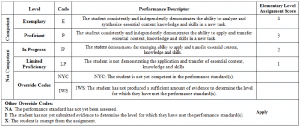In Search of the Goldilocks Scale
CompetencyWorks Blog

We have learned a lot over the past five years as our district has implemented a competency-based model of grading and assessing. Competency-based grading and assessment requires a significant shift in the way we think about assessment—its purpose and its meaning. Our school, Memorial School in Newton, NH and our district, the Sanborn Regional School District, moved to this model five years ago. We continue to learn more about what assessment of students truly means as our overall understanding of assessment practices (our assessment literacy) increases.
When we moved to this model of grading and assessment, our elementary teachers made a wholesale change to grading with a four-point rubric. There would be no number scale (100 point scale) and there would be consistency across grade levels horizontally and vertically. The grade scale rubrics we used would identify the expectations around each level. Our learning curve was steep as we created the rubrics, but we found that our learning was not going to stop there. It continues to this day.
Our first year, we identified our rubric indicators as E (Exceeding), M (Meeting), IP (Inconsistent Progress), and LP (Limited Progress). The chart below reflects this first attempt at our rubric scale. The first roadblock came after the first progress report was distributed. As an educational staff, we looked at IP as what the descriptor outlined—inconsistent progress. A student was able to demonstrate competency, but it was on an inconsistent basis. Many parents provided feedback that it just “felt negative” (the word inconsistent). We decided that “In Progress” was also an accurate indicator, and parents agreed. We made the change immediately within the “Level” while keeping the performance descriptor the same.

Many parents also immediately identified an E as equal to an A. This was understandable and something we actually had anticipated. If we were to line the two scales up side-by-side, the two would APPEAR to correlate, but I attempted to communicate time and time again that they were not the same. Parents wanted to hold their children accountable to getting all Es, when in reality, we were striving for students getting to the level of M. A Meeting score truly demonstrated they were proficient in the competencies they needed to be. An E was really a difficult score to achieve. It demonstrated the transfer of a student’s understanding of the content to a very high level (Hess’ Cognitive Rigor Matrix).
Our teachers’ growth related to Exemplary work was significant and continues to this day. We realized early on that we had not been providing the opportunities for students to demonstrate level 4 work within our assessment of their learning. Teachers recognized that in the traditional 100 point scale we had used prior to moving to a competency-based system, a student who received a 100 was really “meeting” the standard. We were not providing true opportunities for students to demonstrate extended levels of competency through transfer of skills and problem solving required for a student who might now truly attain an E.
With these realizations came some significant changes. Teachers were able to begin to recognize work specific to the various rubric scales. Differentiating between an IP (In Progress), an M (Meeting), and an E (Exceeding) became easier, as we had work samples to dissect in our teams. Teachers built assessments that would allow students the opportunities to demonstrate a higher understanding of the content. Teachers recognized when looking at student work that their instruction may not have been at a level 3 and 4. Specifically, that students struggled when assessed through performance assessments that required level 3+ thinking when they hadn’t had a chance to practice that type of learning enough leading up to the assessment. They adjusted their instructional practices to ensure that students were assessed in ways that were consistent to their daily instruction.
Systemically, we have worked very hard within our district to provide consistency across all grades and levels. We recognized that this was very important because to do otherwise would cause confusion as students transitioned from elementary to middle school and from middle school to high school. Last June, a group of teachers from across our district sat in a room and hammered out a set of consistent indicators with a corresponding scale. With what we had learned over the past five years as the foundation for this work, our teachers, K-12, agreed upon changing E to Exemplary because it better defined the type of work, not necessarily the amount of work (previously it had been Exceeding). We agreed upon changing the indicator of Meeting to Proficient across all grades. Additionally, we added in override codes for those students who had not produced sufficient work for us to make a determination of their competency (IWS-Insufficient Work Shown). These new changes are reflected below:

The learning curve when moving to a competency-based educational model is steep. As our Director of Curriculum, Ellen Hume-Howard, says, “It took us several years to find our Goldilocks (just right) scale.” Districts and schools must be willing to continuously examine their work, respond (when appropriate) to feedback from stakeholders, and continue to keep the learning and progression of students at the forefront when making decisions. This commitment will allow true understanding to take hold and for students to truly receive a personalized education based upon their individual needs.
Jonathan is the Director of Innovative Projects for the New Hampshire Learning Initiative, overseeing the personalized and competency-based work related to NG2: Next Generation Collaborative Learning Design and the State of New Hampshire’s efforts integrating Work Study Practices into curriculum, instruction, and assessment.
Formerly, Jonathan was principal of Memorial Elementary School in Sanborn Regional School District in New Hampshire. Under his leadership, Memorial became a nationally recognized model professional learning community (PLC) on All Things PLC (allthingsplc.info) and competency-based learning elementary school.
Jonathan lives with his wife and three children on the New Hampshire Seacoast. You can follow Jonathan via Twitter @jvanderels